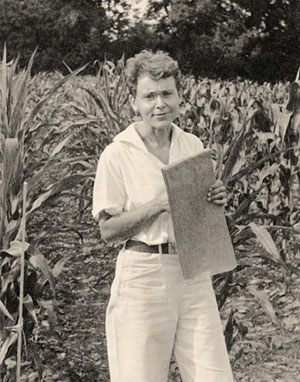
Barbara McClintock's World
Barbara McClintock was born in Hartford, Connecticut. Her father was an army doctor and her mother was a piano teacher. McClintock was an active child and enjoyed many sports like volleyball, skating, and swimming. She had a passion for information, and in a time when a woman's career was a successful marriage, McClintock was determined to go to college. In 1918, she enrolled in Cornell University, the College of Agriculture.

Under the social and intellectual background of college, McClintock blossomed into a popular coed. By the time she finished her undergraduate credits, she found herself in graduate school in the new field of cytology. As a paid assistant in her second year of graduate work, she improved on a method that her employer was using and was able to identify maize chromosomes. It was a problem he had been working on for years and she effectively scooped her own boss.
When she finished her Ph.D. in 1927, McClintock knew that her next step was to map corn chromosomes in linkage groups like T. H. Morgan's group was doing for Drosophila. To do this work, McClintock stayed at Cornell as an instructor. She met fellow graduate students Marcus Rhoades and George Beadle who became lifetime friends as well as colleagues. McClintock helped Beadle sort out the Neurospora chromosomes. Beadle, with Edward Tatum, built on this work and developed the "one gene, one enzyme" theory using Neurospora.
In 1929, McClintock met Harriet Creighton, a new graduate student at Cornell. The two of them became friends and worked together to show that chromosomal crossovers occur in corn chromosomes.
In 1931, supported by a fellowship from the National Research Council, McClintock started splitting her time between the University of Missouri and Cornell. She began investigating the effects of X-rays on corn chromosomes, which led to her discovery of translocations, inversions, deletions and ring chromosomes in corn.
After a depressing and disappointing sojourn in Germany in 1933, McClintock returned to Cornell and with some support from the Rockefeller Foundation managed to stay for almost three years. In 1936, she was finally offered a faculty position at the University of Missouri. McClintock was assistant professor at the University for five years until she realized that her independent and "maverick" ways were not in keeping with the University's idea of a "lady" scientist. Knowing that she would never be promoted, McClintock left in 1941.
Marcus Rhoades, who was at Columbia University, and Milislav Demerec, a Drosophila scientist at Cold Spring Harbor, invited her to Cold Spring Harbor Laboratory for the summer. Rhoades was growing his corn there, and Demerec knew and respected McClintock as a scientist. McClintock stayed for the summer and late into the fall. When Demerec became the Director of the Department of Genetics of the Carnegie Institution of Washington at Cold Spring Harbor, he offered McClintock a position. Undecided at first, McClintock finally accepted the position in 1942. It was at Cold Spring Harbor that McClintock figured out the process of transposition in corn chromosomes. For this and her other work, McClintock was awarded an unshared Nobel Prize for Physiology or Medicine in 1983.
Although many people recognized McClintock's genius, she herself admitted that sometimes it was difficult for her to express her ideas. Her work on transposition in corn chromosomes was fairly well-known but little understood until the molecular basis for transposition was shown in 1970s. McClintock was frustrated by other people's lack of understanding and acceptance of an idea that was so clear and reasonable to her.
McClintock was a research investigator at Cold Spring Harbor until her death in 1992. She enjoyed playing tennis. Each fall, she was often seen on the Cold Spring Harbor grounds collecting black walnuts for use in baked goods that she gave to a favored few of her colleagues. In addition to her brilliance as a geneticist, many people remember her quick wit and her sense for fun. She was dedicated to, and passionate about her work, and was happiest in the cornfield or in her laboratory.


